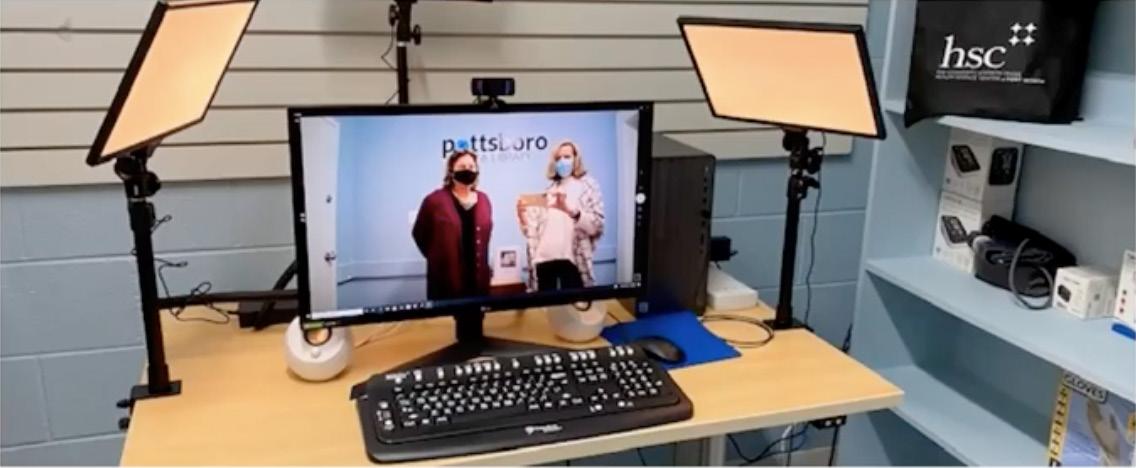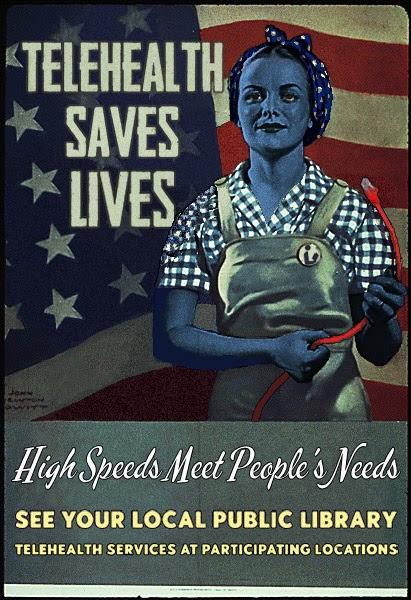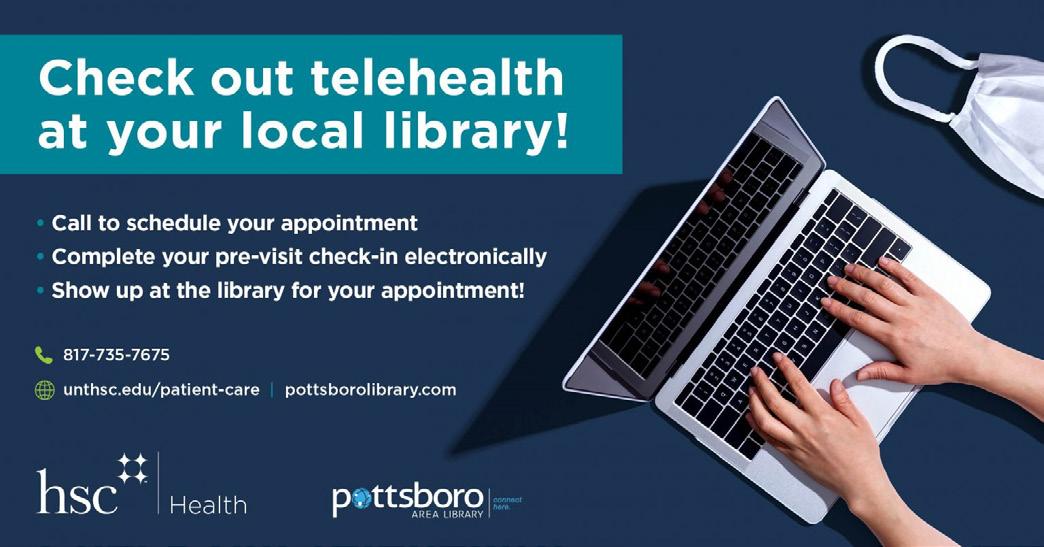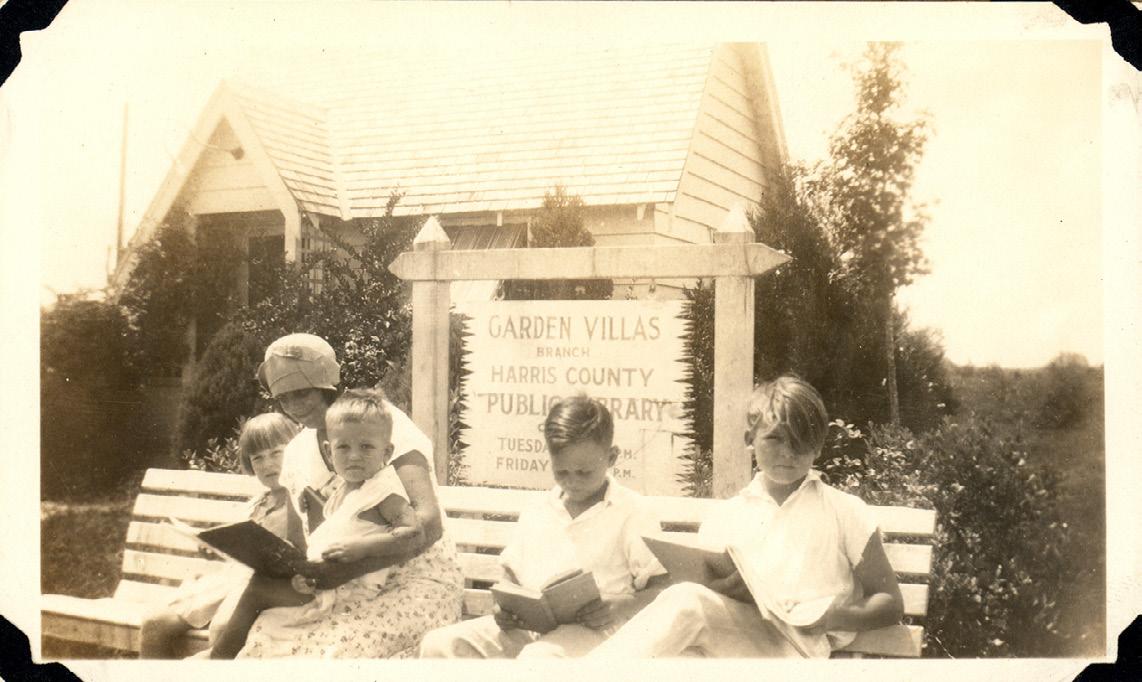
7 minute read
Libraries as Telehealth Providers
The telehealth setup at Pottsboro Public Library has strong lighting, allowing physicians to view their patients clearly. Photo credit: Pottsboro Public Library
A RURAL CASE STUDY
By Michele Chan Santos
FOR RURAL COMMUNITIES, TELEMEDICINE IS BECOMING MORE
IMPORTANT THAN EVER BEFORE. In a time when the COVID-19 pandemic made many physician appointments virtual, and when many small towns lack health care providers, access to a strong internet signal and a computer may mean the difference between consulting a physician or not seeing one at all.
The Pottsboro Public Library, in tiny Pottsboro, Texas (population 2,500), is piloting a telemedicine program that could be a model for many rural communities around the state and the nation. Lessons learned in Pottsboro can be applied to telemedicine efforts at libraries in any community, even on a much smaller scale. Resources and grants used to launch this effort are available to other libraries as well.
The genesis of this effort began when Dianne Connery, special projects librarian in Pottsboro, realized that many people were coming into the library to have virtual appointments with their physicians on the library computers.
“Because of the lack of internet in our area, we have stayed open throughout the whole pandemic,” Connery said. When she realized patrons were talking about personal health concerns, “I would put people in my office so they could have privacy for those conversations.”
Fast forward a few months, and thanks to a $20,000 grant from the Network of the National Library of Medicine, South Central Region, the Pottsboro Public Library now has a room with its own entrance that has been outfitted for telemedicine visits. This former storage room has been converted to a telehealth space with a private computer, good lighting (important for telehealth visits) and a special HEPA filter that keeps the air clean. Appointments have 15-minute gaps between them, to allow surfaces to be disinfected and the air filter to run before the next patient enters.
In addition, the library has a formal arrangement with the physician practice group from the University of North Texas Health Science Center (UNTHSC) in Fort Worth. Physicians there are available to treat patients through virtual visits, accessed through the Pottsboro library. The health science center serves as the managing health care partner for the telehealth visits; they have extensive telemedicine expertise and advised Connery on the equipment and processes needed for a library space to effectively serve as a patient care visit room.
This is how it works: patients call a number to make an appointment. They complete their pre-visit check-in electronically (on their own device, or at

Photo illustration: Henry Stokes, Chair, TLA Innovation & Technology Round Table, and Library Technology Consultant, State E-rate Coordinator for Libraries, Texas State Library and Archives Commission
a kiosk located just outside the library.) Librarians are not told the reason for the visit, just the time the person is coming in.
Twenty-four hours in advance, patients must get a COVID-19 screening. If they are at risk of having COVID-19, it’s recommended they go somewhere else (besides the library telehealth room) for their visit.
When the patient arrives, Connery helps them log into the system and provides any other technical assistance they need. Then she leaves the room so they can speak privately with the health care provider.
After the patient leaves, the room is disinfected. Health sciences center staff “made gallons of specially formulated disinfection liquid,” Connery said. “They taught me how to put that on surfaces and how long to leave it on.”
The virtual visits with UNTHSC physicians are paid for in the same way the patient usually pays for their medical visits. Private insurance, if they have it, and if they do not, “there is an automatic 50 percent discount of what their normal fees are,” Connery said. “They take Medicare and Medicaid; ability to pay is not a barrier.”
The program just launched this spring; now the challenge is getting patients to try this new way of accessing health care.
“We’ve sent out mailers, we posted flyers at pharmacies, the post office, other local businesses, we have posted extensively on social media. We are working on yard signs,” Connery said. She’s also talked with the local public school and with other community groups. The room could be utilized for counseling/mental health visits, as well as medical appointments.
The Texas Library Association’s Innovation Technology Round Table (ITRT) presented a webinar in February which was hosted by Henry Stokes, Texas State Library & Archives Commission library technology consultant. Connery presented and was joined by Jessica Maack Rangel, the vice provost of the Division of Academic Innovation at UNTHSC.
Rangel discussed how efforts in telemedicine help us to rethink how providers can reach people. “At UNTHSC, we sit in the heart of Fort Worth and we have lots of services available,” Rangel said. “What we sometimes forget as a community is the number of rural community hospitals that have closed. There has been an overall shift from inpatient care to people staying home. That’s where we want to be. But in doing that, rural hospitals have closed at a catastrophic rate, leaving many rural communities without any access to health care.” (The full recording of the webinar is available here.)
Dan Burgard is the vice provost of scholarly information management and university librarian at UNTHSC; he’s also the president-elect of TLA. “It’s not a coincidence that our physician group was working up all their telehealth capabilities,” Burgard said. “My guess is that other physician groups could have a similar plan; that part should be replicable around the state. Most
Free Webinar April 14 Telehealth in Rural Public Libraries
The Network of the National Library of Medicine South Central Region is presenting an upcoming free webinar about telemedicine. Speakers are Dianne Connery of Pottsboro Public Library and Jessica Maack Rangel of the University of North Texas Health Science Center. Title: Telehealth in Rural Public Libraries Date: Wednesday, April 14, 2021 Time: 10:00am–11:00am CT
For more information and instructions on how to join the meeting: https://nnlm.gov/scr/
training/connections
physician groups were working on that (telemedicine) before the pandemic hit.” Federal regulations have recently loosened in the area of telemedicine, which “allows better payment for telemedicine visits,” Burgard said. “That’s made the whole thing blossom even more. There’s a huge opportunity in every state for improved telehealth opportunities in rural areas.”
HOW TO INTRODUCE TELEMEDICINE AT YOUR LIBRARY
“Telemedicine in a rural library can mean a whole range of things,” Burgard said. “It could be someone chatting on a computer with their clinician, nurse practitioner or doctor, anything from that to what Dianne has in place now (the separate telehealth room and arrangement with a physician group). It is a continuum of possible arrangements. All can be OK and provide a great service.”
Connery recommended seeking guidance from Brian Leaf, the executive director of the Network of the National Library of Medicine South Central Region.
“The very first step is to take some of the training Brian has available through the National Library of Medicine. NNLM has so much available information, certifications you can get for consumer health information, all kinds of webinars and training,” Connery said.
Leaf encouraged librarians to contact him. “We offer a wide variety of continuing education and grant funding,” Leaf said. “We can’t fund every rural library in the state with telehealth funding, but this (Pottsboro) is our pilot, and we are trying to take these lessons we are learning from Pottsboro to extend to other locations as telehealth sites. We will continue to have funding in the future.”
Leaf explained, “What telehealth looks like, it might look different for each community, organization or library. The grants we give out are for health programming, community programs, health programs. We are all about health information.”
The Pottsboro pilot is an exciting one, and Leaf hopes to see more telemedicine efforts in libraries.
“The type of partnership we have with Dianne, she has an incredible amount of energy, it’s been absolutely amazing, the type of innovation she is coming up with,” Leaf said. “We like innovative partnerships like this. If people have innovative things they want to do to serve the public, we are here for it.”
Michele Chan Santos is the marketing specialist at the Texas Library Association.

This flyer was distributed in Pottsboro area to let people know about the telemedicine program. Photo credit: Pottsboro Public Library




